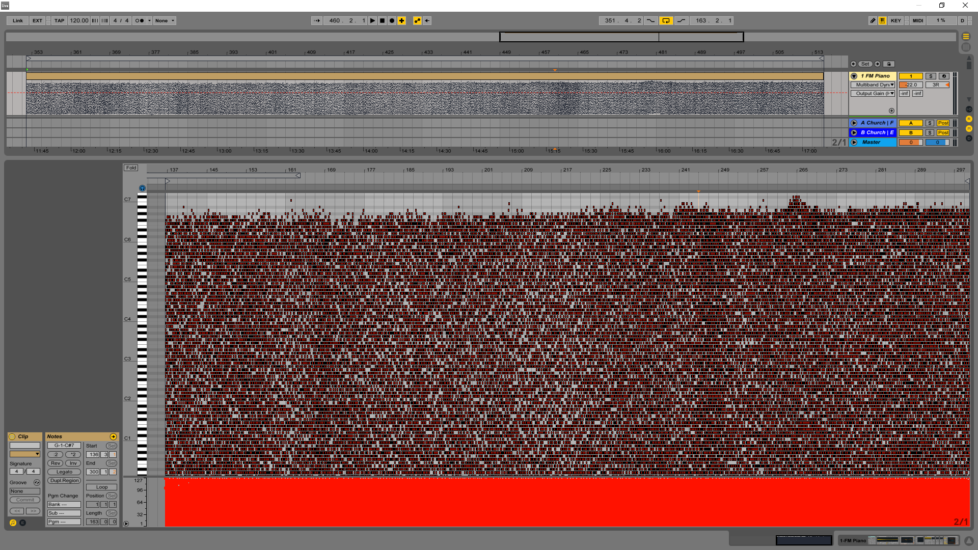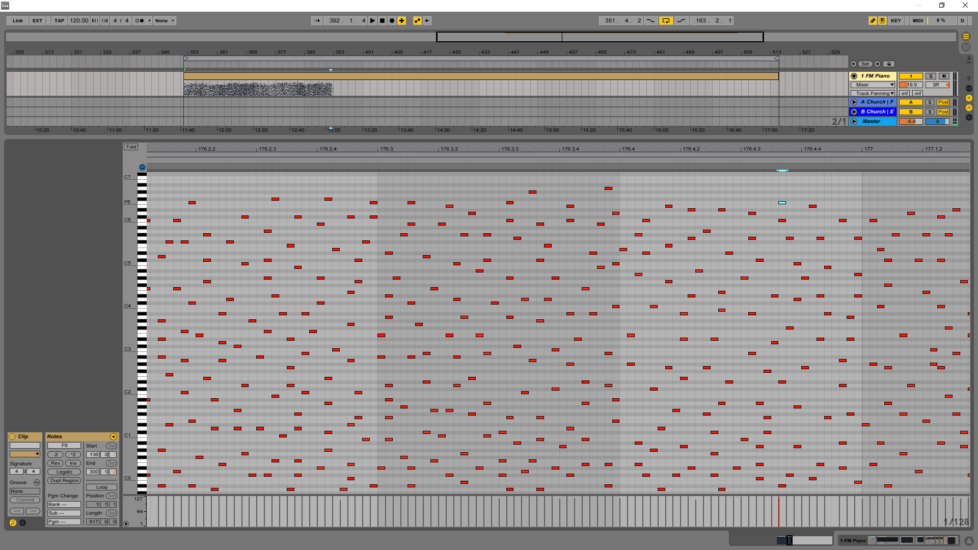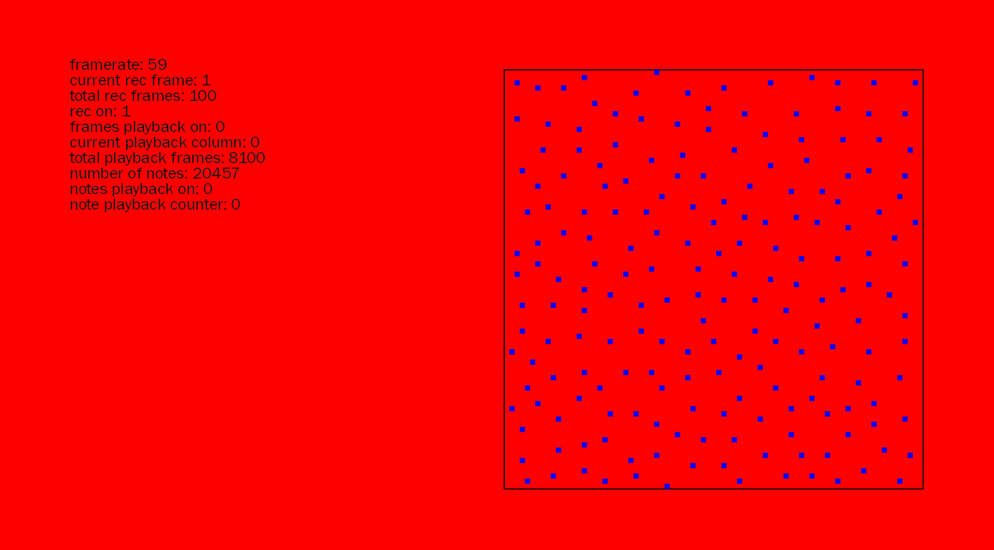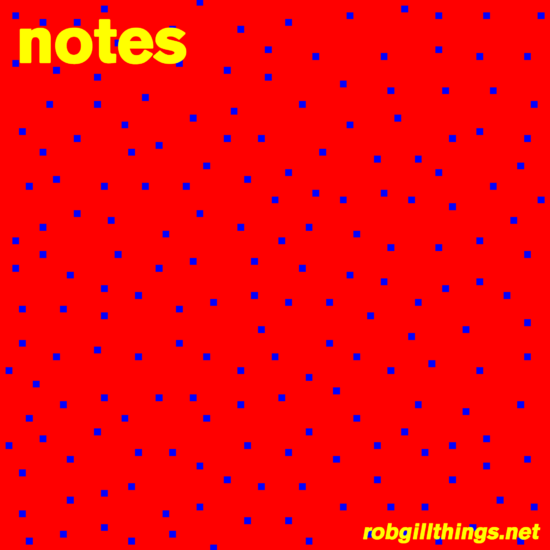September-October 2023
The title of this project is extremely unusual I realize.
This is new software that I have developed using C++ in OpenFrameworks and Supercollider that reproduces the piano roll view that is found in most multitrack audio systems (in this case I am using Ableton Live – see below). I can draw notes and play them back in the same way. The main difference however, and the reason that I wrote this software, is so that I can record the sequence of notes as I draw them – something that is not (easily) available in any standard multitrack such as Live.
There are two modes of playback in my software: a) piano roll where the playback indicator moves from left to right playing the material in the conventional linear fashion and b) notes playback where the notes are played back in the order they were drawn. This is a form of non-linear playback in that the notes will play according to when they were drawn rather than where they are situated in the timeline. So a note appearing later on in a track may play before one that is earlier.
Below are two videos outlining the process.
the audio album
Click the image to be taken to the Bandcamp album page. This album contains the full recordings of all the pieces described on this page.
what

Above is the original ‘sketch’ for the project. It is a five an half minute piece entirely drawn by hand in the piano roll view in Ableton Live. Each red dot is a note. The notes are quantized (snapped to a grid) so they are precisely aligned. I am estimating that there are approximately 20000 notes in this piece – they are very short in duration. You can hear this piece in the above album as track one.

Here you can see a magnified view of the track and the drawn notes. This ‘roughly even scattering’ is a form that I use throughout my work (NETTT). This is a simple and formalized formula for creating artwork that serves as the means for recording, storing, revealing, and transforming living presence. It is a form that avoids elaborate composition in order to not distract from the information that it contains. This is the information that is there by virtue of the material being authored by a living being (me in this case). This is very much in the spirit of scientific investigation where conditions are constrained, the environment is controlled, and variables are removed so that one aspect may be in focus.
living presence encoded in gesture
Any gesture by any living being will communicate living presence. It is this living presence that I am investigating through art. Since any gesture contains this presence, the gestures that make up an artwork don’t have to be anything in particular in order to contain and convey this presence – indeed this is the nature and purpose of art in the first place. The simpler the gestures are, the less ‘compositional baggage’ there is to interfere with and distort the living presence that they already and automatically contain. I employ the simplified form, a ‘roughly even scattering’, in order to ensure that the living presence information that the gestures contain is as clearly legible as possible. This form is also well suited to processes of manipulation and transformation. The notes drawn are stored as a simple list of integer numbers which can be operated on in any number of ways. I am eager to begin working with those numbers to uncover new aspects to the material. I looking towards statistical analysis as a good starting point.
The second track from the album above contains a brief recording of the drawing of notes and this is exactly what inspired this software. I wanted to be able to record the notes – what order they were drawn in – and play them back as a kind of composition. The results can be heard as track four. This is all 20,457 notes being played back in the order that they were drawn at a very high rate of speed. This offers a different view of the material and provides a time-lapse of the creative process.

Above is a screenshot of the software interface. On the right is what a call a ‘frame’ which consists of an 81 x 81 grid. Each blue square (pixel) is a note. This mirrors the piano roll view in the multitrack in that notes are high to low moving vertically from top to bottom and time is measured horizontally. The recording that I use in the video and the album consists of one hundred frames, each drawn individually and approximately like the one shown above – the familiar ‘roughly even scattering’. Conventional playback consists of moving horizontally along the frame playing each column one after the other. With one hundred frames, that means 8100 columns. You can hear playback of this recording in the third track of the above album.
So there are two forms of playback – normal and tracing creation – a song as a direct expression of consciousness.
This project is an example of what I have been working towards in my practice; the development of software which I use to both create artwork and then analyze it afterwards. The secondary notes playback is an example of the kinds of strategies that I develop and use to deconstruct the generated creative material in order to reveal different aspects of it. I have begun studying transpersonal psychology now and it is indeed very promising – expect to see future artwork inspired by what I learn in this field.
what is transpersonal psychology?
Right now I am going through The Wiley Blackwell Handbook of Transpersonal Psychology and I am very encouraged by what I am reading – it definitely applies to what I am exploring in my artwork.
There is a lot of effort and writing in this volume devoted to defining exactly what transpersonal psychology is. Its definition is not as straight forward as it is in other fields such as astrophysics, law, and engineering. A few quotes from chapter one, ‘A Brand from the Burning’ by Glenn Hartelius, Geffen Rothe, and Paul J. Roy:
“Instead, the transpersonal approach seeks a new vision, one in which both human science and human spirituality can be honoured.”
“..psychology of self-expansiveness, whole-person psychology, and psychology of transformative proces..”
regarding the three characterizations of the field that the authors address:
“The first defines the field as a psychology of self-expansiveness, the second as a whole-person, transformative approach to human existence that includes psychology as part of a broader scope of study, and the third as a psychology of transformative process.”
“Transpersonal psychology studies the self conceived not only as isolated individual bound to the here-and-now or the present, but capable of expanding to include others, nature, or all of space and time, or of embodying some larger aspect of the world. These shifted boundaries may be reflected as non-ordinary state of consciousness.”
regarding the transformational aspect:
“Transformative process is a journey in which there is not simply movement from one place or stage to another, but in which the landscape, the destination, and the journeyer shift and change as part of that movement. One might say that
transpersonal as psychology of transformative process understands the individual mind, human communities, and the cosmos itself to be interconnected living systems in constant engagement with creative self-expression and self-invention.”
“Transpersonal psychology, along with humanistic psychology, arose in response to psychologies that reduced the person to their simplest actions, their basest motivations, and their most material structures: bio-machines in a purposeless physical wasteland. In contrast, a transpersonal approach sees certain non-ordinary states as evidence that humans participate in an interconnected whole, evolving purposefully toward unseen but sometimes deeply felt ultimates. It is the sensed presence of this process, whether expressed in the language of science or spirituality, which infuses life with felt meaning. Healing interventions such as psychotherapy then become focused on aligning the personal desire for wholeness with this larger evolutionary current.”
